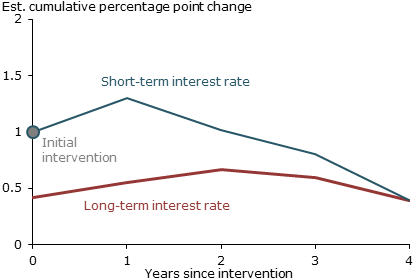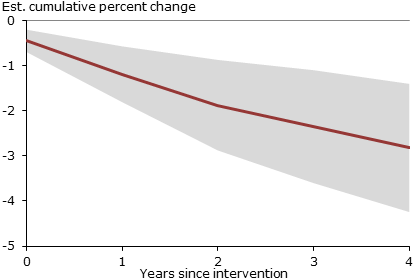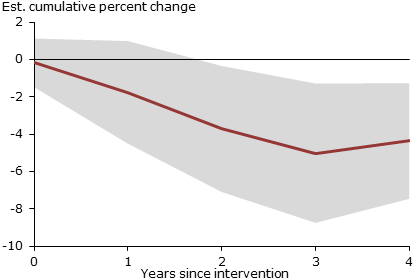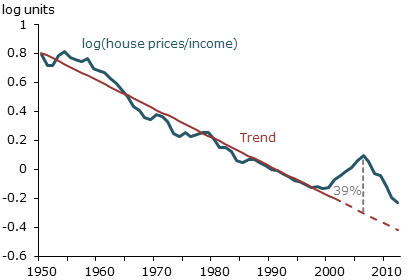There are two conflicting theories on how or even if monetary policy should play a role in stabilizing asset price booms and busts. If central banks use interest rate hikes sufficient to curb leverage and curb booms it might also boost unemployment and lower inflation, deviating from the central bank's goals of full employment and price stability. The alternative is to concentrate on those dual goals and allow financial regulation and supervision to deal separately with threats to financial stability.
A new Economic Letter, Interest Rates and House Prices: Pill or Poison? from the Federal Reserve Bank of San Francisco and written by Òscar Jordà, vice president in the banks Economic Research Department, Moritz Schularick, and Alan M. Taylor professors of economics at the University of Bonn and the University of California, Davis respectively looks at the link between interest rates, mortgage lending, and house prices.
Quantifying this link, the authors say, is important in assessing whether or not interest rate policy can be used to guard against leveraged asset price booms. The largest role in such booms is played by housing because those purchases are typically leveraged through mortgages. In other words, can another housing bubble be prevented by raising mortgage rates?
The housing bubble of 2002-2006 is generally considered a major trigger of the ensuing financial crisis but economists disagree about the degree to which interest rates may have fueled it. The authors conclude that interest rates would have needed an increase of 8 percentage points to completely control the boom-bust cycle. Such an increase however could have caused significant damage to the Fed's twin objectives of full employment and price stability.
The key to curbing a price boom while minimizing other damage is how responsive housing demand is to interest rates. However, directly measuring this responsiveness is very difficult because it reflects the interaction of supply and demand rather than just one or the other. This interaction complicates analysis and illustrates that correlation is not causation. However some historical events can be used as experiments to properly identify the responsiveness, or elasticity, of demand.
Two earlier authors described an interesting international financing paradox. If a country "pegs" its exchange rate - fixing it with another country - and allows capital to flow freely across its borders, then it cannot also control interest rates. The peg removes exchange rate risk and investors would immediately take advantage of any difference in interest rates between the countries. This is sometimes called the trilemma of international finance, since a country cannot have free movement of capital, a fixed exchange rate, and an independent monetary policy at the same time.
By looking at eras of pegged exchange rates dating back to 1870 covering 16 advanced economies or around 90% of the industrialized world during periods when countries have moved in and out of exchange rate pegs the authors could identify periods when interest rates fluctuated independently of conditions such as unemployment and inflation that the central bank normally uses to measure consistency with mandated goals. Examples include gold standard eras, traditional exchange rate mechanisms such as Bretton Woods between 1945 and 1971, and, more recently in Europe, the euro.
However, as the dominant economy, other countries tend to peg their exchange rates to the U.S. and it has seldom handed over the reins of monetary policy, with the exception of the 1879 to 1913 gold standard period. Therefor the authors' research on the elasticity of mortgage lending and house prices to interest rates primarily reflects an average value calculated across countries other than the United States. They say, however, their results are valid to the extent that the shared experience of the industrialized world also applies to the United States.
The authors assumed a 1 percentage point increase to the short term interest rate as a stand-in for the policy rate in year 1 (Figure 1) and then traced the cumulative response of rates for a five-year government riskless security. As anticipated by the literature the long-term rates did not respond one-to-one to short-terms rates, only about half of the short-term fluctuations passed through to the long-term rate.

The behavior of the long-term rate is a proxy for mortgages rates for which the authors did not have data and Figure 2 traces the cumulative response of mortgage lending to their increase. While the impact is initially quite muted, over time lending shrinks, declining about 2.8 percentage points over four years (measured as a ratio to GDP).

Not surprisingly, house prices (Figure 3) suffer a similar fate. House prices (ratio of change to per capita income) fall, slowly at first, but by the fourth year the accumulated decline is about 4.4 percent.

So how much would interest rates have needed to increase to keep housing prices in check during the 2002-06 housing bubble? Figure 4 displays post-World War II ratio of house prices to income stated in log terms; changes can be read approximately as percentage changes. The ratio had declined steadily until 2002 and the authors extrapolated the 1950-2002 trend out through 2006. They then calculated the percent difference between actual observed house prices and this trend to be about 40 percent, similar to what would result from a comparison of house prices to the consumer price index and close to the price boom experienced in the United Kingdom.

Since a 1 percentage point increase in the short rate translates into about a 4.4 percent decline in house prices, the authors calculated that keeping house prices on trend would have required about an 8 percentage point increase in the federal funds rate in 2002. Instead the rate stayed between 1 and 1.25 percent from the end of 2002 until the June 2004 when it rose 4.25 percentage points, reaching 5.25 percent by June 2006. In the authors' experiment, the rate would have been about 8 percentage points higher at the end of 2002, but would have ended at about the actual level of June 2006. Roughly speaking, such a large increase in interest rates would have depressed output more than did the Great Recession.
The authors caution with several caveats to their results. First, the initial increase to the federal funds rate could have been smaller; preventing the crisis might not have required returning house prices back to trend. Second, households might have eventually revised their expectations about the Fed's new resolve against asset price booms, thus requiring a smaller initial intervention. Third, even a fraction of that 8 percentage point increase would probably have sunk the economy into recession, slowing prices even more rapidly although at a cost of added unemployment. Then there is the inevitable uncertainty that surrounds any empirical analysis.
The authors conclude that slowing down a housing boom is likely to require a considerable increase in interest rates, probably one widely at odds with maintaining full employment and price stability and would also require the Fed have a crystal ball to foretell upcoming booms. "In restraining asset prices, while the power of interest rate policy is uncontestable, its wisdom is debatable," the authors say.







